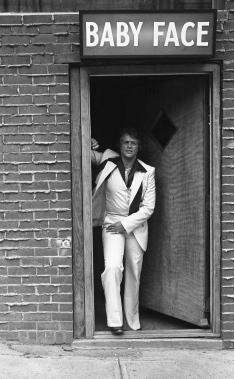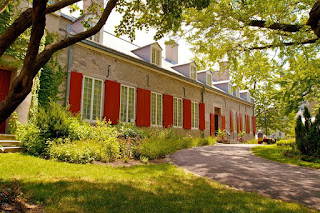 |
| Was Oscar Wilde inspired to write The Selfish Giant by his visit to Montreal in 1882? |
Montreal
is a top LGBTQ tourism destination, but the city wasn’t always the gay mecca it
is today. Back in the 17th century it was just a tiny outpost
of the French Empire, surrounded by fields and valleys as far as the eye could
see. It was here in 1648 that a gay military drummer with the French garrison
stationed to protect the Sulpician Order of priests — the seigneurs of Montreal
— was charged by the Order with committing “the worst of crimes” and sentenced
to certain death in the galleys.
“The
drummer’s life was spared after Jesuits in Québec City intervened on his
behalf,” Québec Gay Archives co-founder Ross Higgins said. “He was given a
choice by the Roman Catholic Bishop of Québec: die or become the colony’s first
executioner.”
The
unidentified drummer took the executioner job.
 |
| Champ-de-Mars in Montreal (Photo courtesy McCord Museum) |
So
it was in Montreal, where fewer than a thousand settlers endured grueling
winters and disease for decades, and where guards stood on duty against Indians
to protect workers tilling the fields outside their walled town.
During
this period, military records show that a decade before the French signed a
multilateral peace treaty with 38 North American native tribes at the inaugural
Meeting of First Nations in Montreal in 1701, two soldiers and their
lieutenant, Nicholas Daussy de Saint-Michel — likely caught having a threesome
— were thrown into a bailiff’s prison and charged with sodomy. Daussy was fined
and the soldiers banished from New France.
Though
few records documenting gay and lesbian life anywhere in North America over the
next 150 years have survived, historians agree that gays and lesbians managed
to thrive in gateway cities like Montréal. Newspaper clippings from this period
clearly indicate Old Montreal’s military Champs de Mars (today located directly
behind Montréal City Hall) was a popular cruising ground for gay men.
The
first recorded gay establishment in North America was Montrealer Moise
Tellier’s “apples and cake shop” on Craig Street (now Saint-Antoine)
in 1869, where men met and had sex.
Then,
during Montreal’s Sin City heyday that began with
American prohibition and continued with the return of World War II Canadian
military recruits (who knew they weren’t the only gays and lesbians out in the
world), dozens of gay bars opened up downtown.
Gay
men were first allowed to dance together in Montréal on August 27, 1958, to
celebrate the birthday of legendary female impersonator Armand Monroe —
a.k.a. “La Monroe” — in the Tropical Room of the Down Beat
club located at 1422 Peel Street.
"When
I began managing the bar,” Armand explained, “I introduced a new policy: gay
customers served by gay waiters and gay bartenders!"
 |
| Babyface outside her disco, circa 1980 (Photo by Suzanne Girard) |
Meanwhile, Denise
Cassidy — better known by her nickname Babyface, inherited
from her brief stint as a professional wrestler — went on to manage six of
Montréal’s first lesbian bars from 1968 to 1983.
"The
first bars were pretty tough,” Cassidy said. “It was a hard milieu, especially
when men discovered my bars were for women only."
Montreal’s
queer demimonde would also endure police harassment for many decades — notably
the 1977 police raid on the Truxx leather cruising bar — until patrons fought
back following the July 15, 1990, early-morning police raid on the Sex Garage
loft party, widely considered to be Montreal’s Stonewall.
Sex
Garage lead directly to the creation of the city’s famed Black and Blue circuit
party and now-defunct Divers/Cité Queer Pride Parade and Festival, which fueled Montreal’s booming Gay Village and put
the city on the international gay map. Activism directly sparked by Sex Garage
also lead to landmark legal victories – such as pension benefits and same-sex
marriage – by the LGBTQ community. By the time Montreal hosted the inaugural
World OutGames in 2006, the city was lauded as one of the most queer-positive
on the planet.
 |
| Sex Garage was Montreal's Stonewall (Photo © Linda Dawn Hammond) |
During Montreal’s 375th anniversary celebrations
in 2017, the city’s FiertéMontréal Pride organization will host the inaugural Fierté Canada Pride parade and
festival. Modeled on EuroPride and WorldPride, Fierté Canada Pride is expected
to draw 750,000 spectators.
 |
| Fierté Montréal Pride drawns hundreds of thousands of spectators each year (Photo by Allison Slattery) |
Here are 12 stops to create your own historical walking tour of Gay Montreal:
1)
1428 Stanley Street: the former
location of leather-cruising bars Truxx and Le Mystique where Montreal police
raids on October 22, 1977, sparked demonstrations the next day.
 |
| Hollywood and The Lime Light |
2)
1254 Stanley Street, above where Chez Parée stands today: Montréal’s famed Limelight was the biggest disco-era
nightclub after Studio 54. The Limelight building also included the Le Jardin
gay disco. Next door was the Hollywood Disco, a gay cruising bar, and
next to the Hollywood was Bud’s Lounge, an all-male gay leather bar.
3)
1422 Peel Street: The Down Beat
nightclub became a hotspot following the debut of legendary female impersonator
Armand Monroe (aka Marilyn Monroe impersonator “La Monroe”). Gay men were first
allowed to dance together in Montréal on the night of Aug. 27, 1958, to mark
Armand Monroe’s birthday. The Down Beat later became the gay PJ’s nightclub.
 |
| Armand Monroe at PJ's |
4)
1455 Peel Street: In 1944,
Liberace was being paid $350 a week to play at the now-defunct Mount Royal
Hotel. A savvy publicist suggested changing he change his name from Walter
Liberace (pronounced Lib-ber-ayse) to the more showbiz Liberace with a hard-c
Italian pronunciation. A Las Vegas legend was born.
5)
Guy Métro station, the former location of Her Majesty’s Theatre: A chance encounter backstage with Marlene Dietrich
backstage in October 1960 led to Montréaler John Banks being hired as her
personal secretary for the next 12 years.
Read the whole story here.
In 1979, John Banks (along with Armand Monroe) organized the first Pride march in Montreal, to mark the 10th anniversary of Stonewall.
Read the whole story here.
In 1979, John Banks (along with Armand Monroe) organized the first Pride march in Montreal, to mark the 10th anniversary of Stonewall.
6)
494 De la Gauchetière Street West, the location of the now-defunct Sex Garage: This is where the police raid on the morning of July 15,
1990, sparked a movement of LGBT activism in Montréal for years to come.
7)
Saint-Antoine Street (formerly Craig Street) near the corner of Saint-Laurent
Boulevard: The first recorded gay establishment
in North America was Montrealer Moise Tellier’s “apples and cake shop” on Craig
Street.
 |
| Marlene and John Banks |
8)
1230 Saint-Laurent Blvd: A showbar since
1895, the Café Cléopatra strip joint is the last remaining hold-out from
Montréal’s famed and infamous Sin-City era. Historically a safe space for
Montreal’s trans community, the second-floor show bar still hosts drag
performances, fetish parties and burlesque shows.
9)
Saint-Laurent Boulevard from Sherbrooke to Duluth:
Montréal’s first Gay Pride parade was held in June 1979 with 52 marchers. In 2017,
some 750,000 people are expected to attend the inaugural Canada Pride parade, which
will run west to east on René-Lévesque Boulevard.
10)
280 Notre-Dame East Street: The Château Ramezay
gardens were visited by none other than Oscar Wilde during Wilde’s lecture tour
of North America in 1882. While in Montreal, Wilde stayed at the Windsor Hotel.
Local legend has it the walled Château Ramezay gardens inspired Wilde to write The Selfish Giant.
The
Château Ramezay gardens used
to spread over 4,200 square metres and include an orchard as well as vegetable
and flower gardens. Today only 750 square metres remain due to urban development,
and a typical New France Governor’s Garden has been recreated and can be toured
for free.
 |
| Chateau Ramezay Museum, circa 2017 |
Also, in 1775, Benjamin Franklin stayed at the Château
Ramezay – then the Canadian headquarters of the American Revolutionary Army –
when he tried to persuade Montreal to join the revolution.
11)
1235 René-Lévesque Boulevard West: Montreal
nightlife pioneer Denise Cassidy – better known as Babyface from her brief
wrestling career – opened Montréal’s first lesbian-only nightclubs. From 1968
to 1972 she managed La Source and La Guillotine, and from 1973 to 1983 she ran
Baby Face Disco.
 |
| Café Cléopatra, circa April 2017 (Photo by Richard Burnett) |
12)
Sainte-Catherine Street East between Saint-Hubert and Papineau: Montreal’s Gay Village got its name in 1984 when Priape
co-founder Bernard Rousseau opened the “Cinéma du Village”, today the Théatre Le
National rock-concert venue located at 1220 Sainte-Catherine Street East.
This is an updated 2017 version of Bugs' story which originally ran on the Tourisme Montréal blog on May 27, 2015.
No comments:
Post a Comment